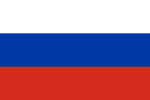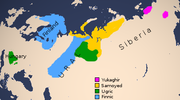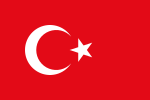Linguistic homeland (redirect from Urheimat)
In historical linguistics, the homeland or Urheimat (/ˈʊərhaɪmɑːt/ OOR-hye-maht, from German ur- 'original' and Heimat 'home') of a proto-language is the...
45 KB (4,951 words) - 09:57, 17 January 2025
Proto-Semitic language (redirect from Proto-Semitic Urheimat)
family. There is no consensus regarding the location of the Proto-Semitic Urheimat: scholars hypothesize that it may have originated in the Levant, the Sahara...
59 KB (6,227 words) - 22:34, 12 January 2025
Proto-Afroasiatic homeland (redirect from Afro Asiatic Urheimat)
The Proto-Afroasiatic homeland is the hypothetical place where speakers of the Proto-Afroasiatic language lived in a single linguistic community, or complex...
48 KB (5,506 words) - 09:47, 12 January 2025
Proto-Indo-European homeland (redirect from Proto-Indo-European Urheimat)
2015 gave support to the steppe hypothesis regarding the Indo-European Urheimat. According to those studies, specific subclades of Y chromosome haplogroups...
121 KB (14,243 words) - 10:17, 11 January 2025
Hungarian prehistory (redirect from Hungarian Urheimat)
after around 2600 BC caused new migrations. No scholarly consensus on the Urheimat, or original homeland, of the Ugric peoples exists: they lived either in...
90 KB (11,101 words) - 20:45, 17 January 2025
Proto-Malayic language (section Urheimat)
ter bepaling van het stamland der Maleisch-Polynesische volkeren, the Urheimat (homeland) of the Proto-Malayic speakers was proposed to be at the Malay...
9 KB (805 words) - 10:26, 30 November 2024
Kra–Dai languages (redirect from Tai–Kadai Urheimat)
(Proto-East Asian). Vovin (2014) has proposed that the location of the Japonic Urheimat (linguistic homeland) is in southern China. He argues for typological evidence...
35 KB (3,490 words) - 00:55, 24 December 2024
Anatolian hypothesis (redirect from Anatolian Urheimat)
The Anatolian hypothesis, also known as the Anatolian theory or the sedentary farmer theory, first developed by British archaeologist Colin Renfrew in...
23 KB (2,664 words) - 15:58, 19 December 2024
Yuman–Cochimí languages (section Urheimat)
aquatic phenomena as evidence against a coastal, lacustrine, or riverine Urheimat. Proto-Yuman reconstructions by Mixco (1978): Laylander, Don (2010). "Linguistic...
8 KB (519 words) - 17:56, 15 December 2024
places the Volga-Dnieper region of southern Russia and Ukraine as the urheimat of the Proto-Indo-Europeans. Early Indo-European migrations from the Pontic–Caspian...
374 KB (33,829 words) - 23:54, 20 January 2025
Tupian languages (section Homeland and urheimat)
are Tupi proper and Guarani. Rodrigues (2007) considers the Proto-Tupian urheimat to be somewhere between the Guaporé and Aripuanã rivers, in the Madeira...
26 KB (1,186 words) - 21:38, 15 December 2024
South Cushitic languages (section Urheimat)
The South Cushitic or Rift languages of Tanzania are a branch of the Cushitic languages. The most numerous is Iraqw, with one million speakers. Scholars...
10 KB (1,060 words) - 04:25, 17 January 2025
Proto-Bantu language (section Urheimat)
Proto-Bantu is the reconstructed common ancestor of the Bantu languages, a subgroup of the Southern Bantoid languages. It is thought to have originally...
20 KB (2,015 words) - 15:08, 1 November 2024
The name Uralic derives from the family's purported "original homeland" (Urheimat) hypothesized to have been somewhere in the vicinity of the Ural Mountains...
89 KB (7,617 words) - 18:53, 10 January 2025
Niger–Congo languages (redirect from Niger-Congo urheimat)
Niger–Congo is a hypothetical language family spoken over the majority of sub-Saharan Africa. It unites the Mande languages, the Atlantic–Congo languages...
64 KB (7,240 words) - 17:17, 18 January 2025
languages, and point to a steppe origin. The archaeological part posits an "Urheimat" on the Pontic steppes, which developed after the introduction of cattle...
238 KB (27,843 words) - 20:42, 18 January 2025
founding population of Rom almost certainly experienced in their south Asian urheimat. Many subgroups use names derived from the Romani word kalo or calo, meaning...
215 KB (20,402 words) - 16:31, 17 January 2025
Proto-Indo-Europeans (section Urheimat hypotheses)
tackled the question of the Indo-Europeans' original homeland (also called Urheimat, from German), had essentially only linguistic evidence. They attempted...
54 KB (6,411 words) - 06:10, 20 December 2024
Proto-Uralic homeland (redirect from Uralic urheimat)
BC) with the Proto-Uralic urheimat, and the following Volosovo culture (ca. 3650–1900 BC) with the Proto-Finno-Ugric urheimat. Two Finnish scholars believe...
33 KB (4,343 words) - 13:55, 11 August 2024
Yugra (section Hungarian Urheimat)
Hungarians' ancestral home. Contemporary Uralic linguistics locates the Urheimat of the Ugric language family to Southwestern Siberia, at the margin of...
26 KB (3,763 words) - 07:35, 16 December 2024
Proto-Yoruboid language (section Urheimat)
Proto-Yoruboid is the reconstructed common ancestor of the Yoruboid languages, a subgroup of the Volta-Niger languages. It was likely spoken in what is...
10 KB (1,098 words) - 23:56, 19 October 2024
the common era, archeological and linguistic evidence suggest that the Urheimat ('original homeland') of the Proto-Germanic language, the ancestral idiom...
164 KB (20,237 words) - 15:26, 19 January 2025
Lachsargument) is an outdated argument in favour of placing the Indo-European urheimat in the Baltic region, as opposed to the Eurasian Steppe, based on the cognate...
16 KB (2,035 words) - 06:36, 16 January 2025
Proto-Algonquian language (section Urheimat)
Algonquian family. There remains some disagreement over the Algonquian Urheimat (homeland of the protolanguage). The initial theory, first put forth by...
29 KB (3,272 words) - 20:33, 21 March 2024
the region during the ensuing Neolithic era from the family's proposed urheimat ("original homeland") in the Nile Valley, or the Near East. The majority...
228 KB (22,194 words) - 21:04, 19 January 2025
Uralic–Yukaghir languages (section Urheimat)
Uralic–Yukaghir, also known as Uralo-Yukaghir, is a highly controversial proposed language family composed of Uralic and Yukaghir. Uralic is a large and...
20 KB (1,975 words) - 20:10, 10 September 2024
developed at the latest by the 3rd millennium BC (see Proto-Indo-European Urheimat hypotheses). Thus, the pre-Indo-European languages must have developed...
15 KB (1,567 words) - 15:20, 24 December 2024
providing evidence of a possible linguistic homeland (also known as a Urheimat).[citation needed] The centre of Albanian settlement remained the Mat River...
179 KB (17,142 words) - 05:08, 18 January 2025
Eastern Mongolia" Lee & Kuang 2017: "The best candidate for the Turkic Urheimat would then be northern and western Mongolia and Tuva, where all these haplogroups...
246 KB (25,417 words) - 07:01, 18 January 2025
Proto-Afroasiatic language (section Urheimat)
Proto-Afroasiatic (PAA), also known as Proto-Hamito-Semitic, Proto-Semito-Hamitic, and Proto-Afrasian, is the reconstructed proto-language from which all...
82 KB (9,927 words) - 09:34, 12 January 2025


















